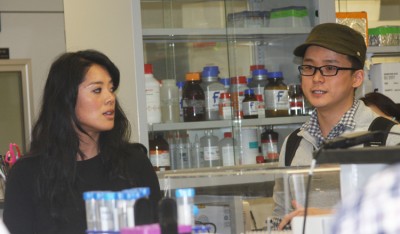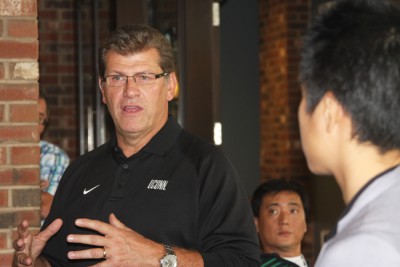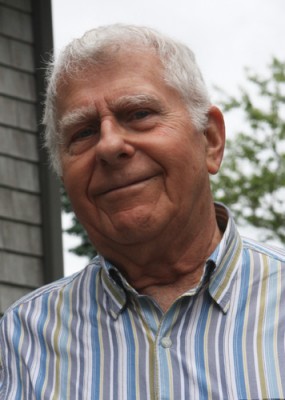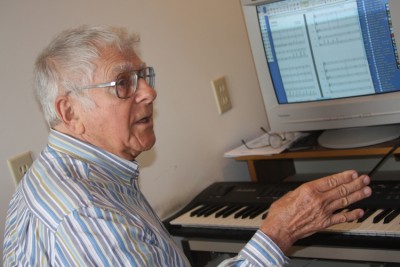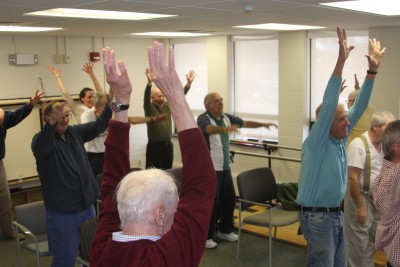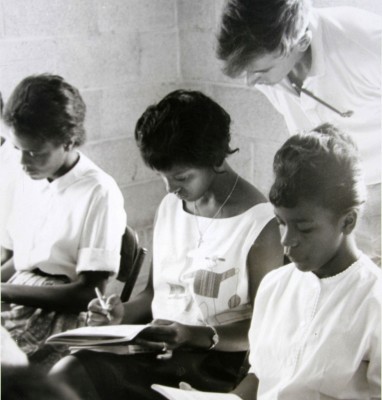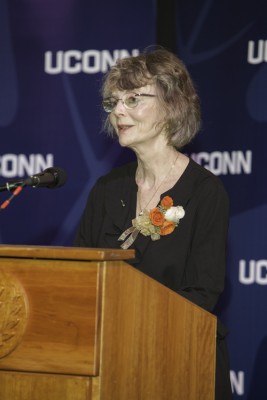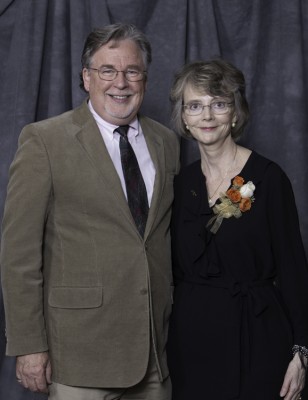 Accolades – below are news and notes from our alumni, faculty, staff, and students. We are proud of all the amazing accomplishments by our Neag family. If you have an accolade to share, we want to hear from you! Please send any news items (and story ideas) to shawn.kornegay@uconn.
Accolades – below are news and notes from our alumni, faculty, staff, and students. We are proud of all the amazing accomplishments by our Neag family. If you have an accolade to share, we want to hear from you! Please send any news items (and story ideas) to shawn.kornegay@uconn.
Students
Austin Johnson (MA ’10 in educational psychology and current doctoral student) placed third in the inaugural UConn 3 Minute Thesis (3MT) competition. 3MT presented a challenge for graduate students to consolidate and crystalize their research ideas into a very brief presentation. After two rounds of judging, he was awarded third place and won a $50 gift certificate to the UConn Co-op. President Herbst recognized the winners at the recent Board of Trustees meeting.
Giselle Garcia (secondary mathematics junior) and Estephani Orellana (secondary mathematics junior) were recently recognized at the Diversity Dinner as Hearst Scholarship Recipients.
Alumni
Alumni
The Neag Alumni Society, in conjunction with CLAS, welcomed UConn alumnus Bryan Schultz to screen a chess documentary, Brooklyn Castle. The event included panelists, Michele Femc-Bagwell, and Ruth Lyons (director of the Renzulli Academy), along with the film’s producer and a UConn chess team member.
Social studies alumni recently came back to the UConn campus for dinner, networking and a panel discussion. Alan Marcus organized the event, welcoming back interested alumni. Panelists included Richard Gonzales, Jeff Moore (IB/M ’06 assistant principal at the Academy of Aerospace and Engineering), Dave Maloney (social studies department chair at Manchester HS), and Dorothea Anagnostopoulos.
Meghan Angeletti (BS ’06 in sport leisure) was recognized with “30 under 30” by the Racquet Sports Industry for her work as community relations manager for USTA New England. She is the section coordinator for USTA Team Tennis in New England, focusing on growing tennis for 10 and Under Tennis and USTA School Tennis.
David Garvey (Ph.D. ’06 in educational administration) was recognized by ACCESS Community Action Agency for a Community Service Award. He is the director of UConn’s Nonprofit Leadership Program.
Brittany Hunter (BS ’08, MA ’11) recently Skyped into the Sport Based Youth Development class at UConn. Hunter is currently the vice principal of one of the Harlem Success Academies in NYC.
Uyi Osunde (BA ’03, MA ’08) was recently appointed assistant principal at Illing Middle School in Manchester, CT. A former UConn football star and defensive end for the Buffalo Bills, Osunde previously worked as a counselor in East Hartford and New London Schools.
Jocelyn Tamborello-Noble (BS Spanish ’03, MA in education ’04, Sixth-Year ’09) was a 2013 Polaris Award Winner from the Leadership Greater Hartford organization. She is a Spanish teacher at Glastonbury High School.
Denise E. Wilbur (MA ’80 in adult education) was appointed interim-vice president for academic affairs at Lincoln University in Pennsylvania. Prior to that role, she served as vice president for academic affairs and professor education, chief academic officer of the Gwynedd-Valley College in Gwynedd-Valley, PA.
Theodore “Ted” Yungclas (MA ’02 in higher education administration, Ph.D. ’07 in educational psychology) was recently appointed to the State Board of Regents in Hartford. He previously served as the assistant dean at UConn’s School of Fine Arts.
Faculty
Husky Sport is in its 10th year of operation. They have come a long way from their humble beginnings in the summer of 2003 from the living room of Hartford Catholic Workers’ Green House brainstorming on how to best connect UConn students and Hartford youth around sport. Middle school students from 10 years ago are now in college, some about to graduate this year. Others are employed and contributing members of their communities.
Kinesiology hosted a visit of sport scientists and Olympic coaches from China. The coaches were at UConn for one week and the scientists were here for two weeks to learn about research and at UConn. They had lunch with Coach Auriemma, participated with tours of the labs and facilities and heard presentations from doctoral students and faculty members.
Teacher Education recently hosted the annual Diversity Dinner at the UConn Alumni Center, featuring guest speakers Dr. Santosha Oliver (assistant principal at O’Brien STEM Academy) and Mark Jenkins (IB/M student). The focus of the event is to show the support and encouragement for students of color to consider careers in education. Current education students, and prospective students from Bulkeley High School were in attendance to meet Neag alums, Neag professors and university administrators, and community leaders.
Teacher Education hosted a two-day pilot training institute for UConn partners called “RESPECT FOR ALL.” Neag was selected by the National Network for Educational Renewal (NNER) to partner with GroundSpark, an educational and social justice non-profit that ignites change through film. GroundSpark is the home of The Respect for All Project, a national initiative focused on creating inclusive and welcoming school and community environments where young people of all backgrounds and experiences can thrive.
Jennie Bruening, along with other colleagues, published “Exploring the motives and retention factors sport-for-development volunteers” in Nonprofit and Voluntary Sector Quarterly. She has also joined the Public Engagement Executive Committee serving as Co-Chair for Service Learning.
Tutita Casa was selected for a Math Reasoning Expert Panel by the Smarter Balanced Consortium.
Joseph Cooper recently had a manuscript accepted for publication. His manuscript titled, “The Transfer Effect: A Critical Race Theoretical Examination of Black Male Transfer Student Athletes’ Experiences” has been accepted for publication in the Journal of Intercollegiate Sport (JIS).
Michael Coyne and George Sugai’s Connecticut Kindergarten to Grade 3 Literacy Initiative, was recently expanded, through additional state funding, to East Hartford’s John A. Langford Elementary School. The original five-year grant, funded at $1.7M from the state, has five schools in the program.
Lindsay DiStefano testified in DC at a Congressional Briefing on “Healthy and Safe Participation and Athletic Development in Youth Sports – A Call to Action” on behalf of the American College of Sports Medicine and the National Youth Sports Health & Safety Institute. The briefing was in collaboration with Congressional Caucus on Youth Sports.
Mary Anne Doyle received the 2013 Special Recognition Award from the New England Reading Association for contributions and accomplishments in literacy education for the state and region through leadership, teaching, scholarship, and service to colleagues, teachers, students and children.
Shaun Dougherty was named an Emerging Education Policy Scholar by the Thomas B. Fordham Institute. He also had a paper accepted, “Can district-generated literacy interventions be effective?: Lessons from a regression discontinuity design” in Education Finance and Policy.”
Morgaen Donaldson was notified that she is the recipient of the University Council for Educational Administration’s Jack Culbertson Outstanding Junior Scholar Award.
Wendy Glenn was recognized as a 2013 recipient of the Richard A. Meade Award for Research in English Education, sponsored by the National Council of Teachers of English.
Tom Goodkind, coordinator of the annual Northeast Media Literacy Conference at UConn, recently was invited by the Free Press with other media leaders to meet with U.S. Senator Richard Blumenthal in Hartford to discuss the possibility of his co-sponsoring the Television Consumer Freedom Act. As a timely step in one aspect of media policy reform, this bill would let people pay for only the cable channels they actually want — giving them more control over what they buy and watch — referred to as “cable a la carte”.
Robyn Grenier and Morgaen Donaldson, along with other colleagues, published “Making a Change: The Role of External Coaches in School-Based Communities of Practice” in Human Resource Development Quarterly.
Jae-Eun Joo received one-year funding of $63,182 from the CT Health Foundation with the UConn Health Center. The funding will support the development of a series of five online modules for low-income pregnant women. Linda Pescatello’s doctoral student, Yin Wu who took Dr. Joo’s last spring course, will work with her on this in collaboration with the research group at the UConn Health Center.
Kimberly LeChasseur announced that the Early Literacy Project, funded by the Graustein Memorial Fund in conjunction with the CT Center for School Change, is expanding from six communities to 10 this year. LeChasseur will work with these communities to document their community and district partnerships in addressing early literacy.
Alan Marcus has been appointed to the Editorial Board for Theory and Research in Social Education, the most prestigious scholarly social studies journal in the field. He has also been appointed to the committee that is rewriting the State of Connecticut Social Studies Curriculum Frameworks.
David Moss and Tom Levine served on a keynote panel regarding Fairness in Education at the Northeast Educational Research Association Annual Conference on October 25, 2013.
Jonathan Plucker, in conjunction with colleagues at two other universities, recently released a study “Talent on the Sidelines: Excellence Gaps and the Persistence of American’s Permanent Talent Underclass” which found that the highest-performing American students are disproportionately white and wealthy.
Joseph Renzulli recently gave a keynote speech to 600 guests from 35 countries at the International Conference of the Would Council for Gifted and Talented Children in Louisville, KY. He also presented to 350 guests in Indonesia for a conference hosted by the Entrepreneurship Center at the University of Ciputra in East Java.
Sue Saunders was selected as “Best Practices” column editor for the Journal of College and Character (JCC), a publication of NASPA, which focuses on moral and ethical development in college. The JCC announcement currently goes to about 14,000 individuals. The Best Practices column focuses especially on identifying educational practices that are effective in connecting theory and practice and that offer good models for application in the higher education setting, especially for student affairs practitioners.
Diane Ullman presented a workshop to over 100 heads of school and school leaders in Amman, Jordan. The workshop was the culminating event in a weeklong consulting engagement with the Queen Rania Teacher Academy (QRTA) on the topic of school leadership development. This visit marked the launch of a multi-year partnership between the Neag School and QRTA to prepare school leaders for the country’s public schools. She was named chair of the board for the Women’s Education and Leadership Fund (WELFund). The Women’s Education and Leadership Fund (WELFund) was established as a legacy of Hartford College for Women (HCW) in 2006. Through programs, grants, and scholarships, WELFund enhances women’s education and empowers women to lead.
Bob Villanova and Diane Ullman (September 2013-June 2014) serve as lead presenters and facilitators for the Connecticut Association of Public School Superintendents and Neag School of Education Early Career Superintendent Institute.
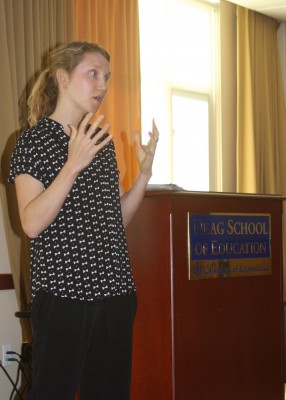
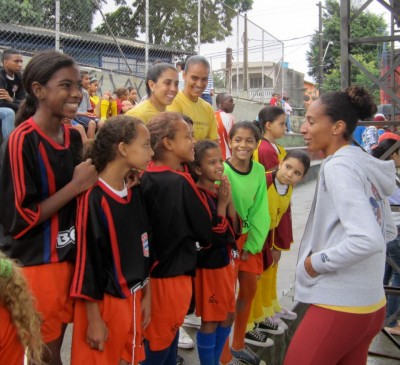


 The Neag School of Education Alumni Society and the faculty of the
The Neag School of Education Alumni Society and the faculty of the 
